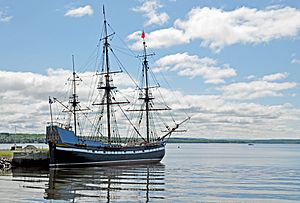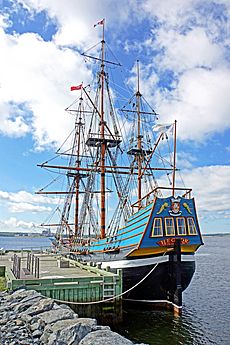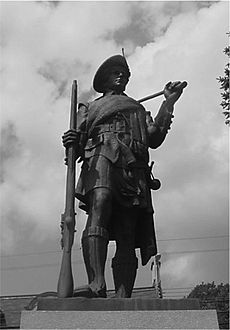Hector (ship) facts for kids
 |
|
| Location | Pictou, Nova Scotia, Canada. |
|---|---|
| Type | Museum ship |
The Hector was a famous ship that brought some of the first Scottish settlers to Nova Scotia, Canada, in 1773. This journey was a big part of the first major move of Scottish people to Nova Scotia. Today, a replica of this historic ship can be visited at the Hector Heritage Quay in Pictou, Nova Scotia. It helps us remember the brave people who traveled across the ocean to start new lives.
Contents
The Original Hector Ship
The original Hector was a type of ship called a Fluyt, built in the Netherlands before 1750. It had three masts and was used for trade around the British Isles. It also carried immigrants to North America, including Scottish people to Boston, Massachusetts, around 1770.
Why People Left Scotland
In 1762, many Gaelic families were forced to leave their homes in the Scottish Highlands. This event was known as the Fuadaich nan Gàidheal, or Highland Clearances. People had to find new places to live.
Some Scottish colonists arrived on "St.-John's Island" (now Prince Edward Island) in 1770. More ships followed in 1772 and 1774. The Hector arrived in Pictou, Nova Scotia, in 1773.
The Famous 1773 Voyage
The Hector's most famous journey began in July 1773. It carried 189 Highlanders who were moving to Nova Scotia. The ship's owner, Mr. John Pagan, and Dr. John Witherspoon bought land near Pictou.
They hired John Ross to find settlers willing to move to Pictou. The settlers were offered free passage, one year of free food, and a farm. Most of the settlers were poor farmers and craftspeople from Lochbroom, Scotland. They mainly spoke Gaelic.
A Difficult Journey
The Hector was an old ship and not in good shape when it left Europe. The trip to Pictou was very long, taking 11 weeks. A big storm near Newfoundland caused a 14-day delay.
Sadly, 18 passengers died during the voyage from diseases like dysentery and smallpox. The ship finally arrived in Pictou Harbour on September 15, 1773.
When they landed, the settlers faced another challenge. The promised year of free food never arrived. They had to quickly build shelters before winter came to avoid starving.
The Hector Replica Ship
Building a New Hector
In the late 1980s and early 1990s, people in Nova Scotia wanted to remember the Hector's important role in Scottish history. In 1992, a group of volunteers formed the Ship Hector Foundation. They started raising money to build a copy of the original Hector.
The Hector Heritage Quay and the Ship Hector Company Store were opened on the Pictou waterfront. Visitors could watch the ship being built, which made it a popular attraction. Experts studied the original Hector to create accurate plans for the replica.
Launching the Replica
After several years of hard work, the replica Hector was launched on September 17, 2000. It was a big event with lots of celebration and media coverage.
Today, the Quay is open from May to October. It has a three-story visitor center. You can also see blacksmith, carpentry, and rigging shops, showing how things were done in the past.
Ship Specifications
Here are some facts about the original Hector:
- Year built: Before 1750
- Location: Pictou, Nova Scotia
- Deck length overall: 25.9 meters (85 feet)
- Beam (width): 6.7 meters (22 feet)
- Gross tonnage: 200
- Number of masts: 3
- Owner: Mr. John Pagan, a merchant from Greenock, Scotland



